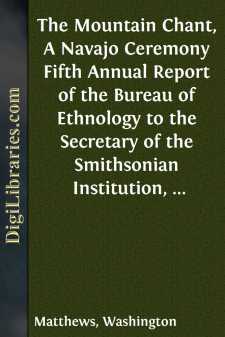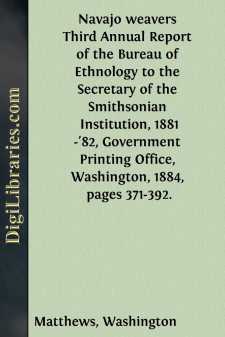Categories
- Antiques & Collectibles 13
- Architecture 36
- Art 48
- Bibles 22
- Biography & Autobiography 813
- Body, Mind & Spirit 142
- Business & Economics 28
- Children's Books 16
- Children's Fiction 13
- Computers 4
- Cooking 94
- Crafts & Hobbies 4
- Drama 346
- Education 46
- Family & Relationships 57
- Fiction 11829
- Games 19
- Gardening 17
- Health & Fitness 34
- History 1377
- House & Home 1
- Humor 147
- Juvenile Fiction 1873
- Juvenile Nonfiction 202
- Language Arts & Disciplines 88
- Law 16
- Literary Collections 686
- Literary Criticism 179
- Mathematics 13
- Medical 41
- Music 40
- Nature 179
- Non-Classifiable 1768
- Performing Arts 7
- Periodicals 1453
- Philosophy 64
- Photography 2
- Poetry 896
- Political Science 203
- Psychology 42
- Reference 154
- Religion 513
- Science 126
- Self-Help 84
- Social Science 81
- Sports & Recreation 34
- Study Aids 3
- Technology & Engineering 59
- Transportation 23
- Travel 463
- True Crime 29
The Mountain Chant, A Navajo Ceremony Fifth Annual Report of the Bureau of Ethnology to the Secretary of the Smithsonian Institution, 1883-84, Government Printing Office, Washington, 1887, pages 379-468
Categories:
Description:
Excerpt
INTRODUCTION.
1. The ceremony of dsilyÃdje qaçàl, or mountain chant—literally, chant towards (a place) within the mountains—is one of a large number practiced by the shamans, or medicine men, of the Navajo tribe. I have selected it as the first of those to be described, because I have witnessed it the most frequently, because it is the most interesting to the Caucasian spectator, and because it is the best known to the whites who visit and reside in and around the Navajo country. Its chief interest to the stranger lies in the various public performances of the last night. Like other great rites of the shamans, it has its secret ceremonies of many days’ duration in the medicine lodge; but, unlike the others, it ends with a varied show in the open air, which all are invited to witness. Another ceremony which I have attended, and which the whites usually call the “Yaỳbichy Dance” (Yèbitcai), has a final public exhibition which occupies the whole night, but it is unvaried. Few Europeans can be found who have remained awake later than midnight to watch it. Such is not the case with the rite now to be described. Here the white man is rarely the first to leave at dawn.
2. The appropriateness of the name dsilyÃdje or tsilgitce—towards (a place) within the mountains—will be better understood from the myth than from any brief description. “Dsilyi‘” may well allude to mountains in general or to the Carrizo Mountains in particular, to the place in the mountains (paragraphs and ) where the originator of these ceremonies (whom I often find it convenient to call “prophet”) dwelt, or to the name of the prophet (par. ), or to all these combined. Qaçàl signifies a sacred song or a collection of sacred songs. From the many English synonyms for song I have selected the word chant to translate qaçàl. In its usual signification hymnody may be its more exact equivalent, but it is a less convenient term than chant. The shaman, or medicine man, who is master of ceremonies, is known as qaçàli or chanter—el cantador, the Mexicans call him. In order to keep in mind his relationship to similar functionaries in other tribes I shall, from time to time, allude to him as the priest, the shaman, or the medicine man, following the example of other authors. To all ceremonies of a character similar to this the term qaçàl is applicable. It would seem from this that the Navajo regard the song as the chief part of the ceremony, but since the Americans, as a rule, regard all Indian ceremonies as merely dances and call them dances, I will, out of deference to a national prejudice, frequently refer to the ceremony as a dance.
3. Sometimes the collective rites and amusements of the last night are spoken of as ilnasjÃngo qaçàl, or chant in the dark circle of branches, from il, branches of a tree; nas, surrounding, encircling; jin, dark; and go, in. The name alludes to the great fence of piñon branches, erected after sunset on the last night, to receive the guests and performers....




